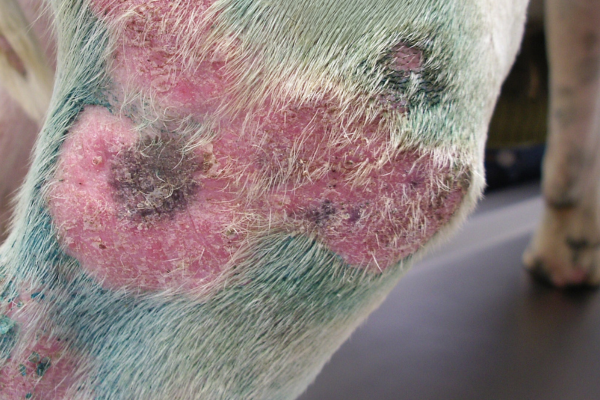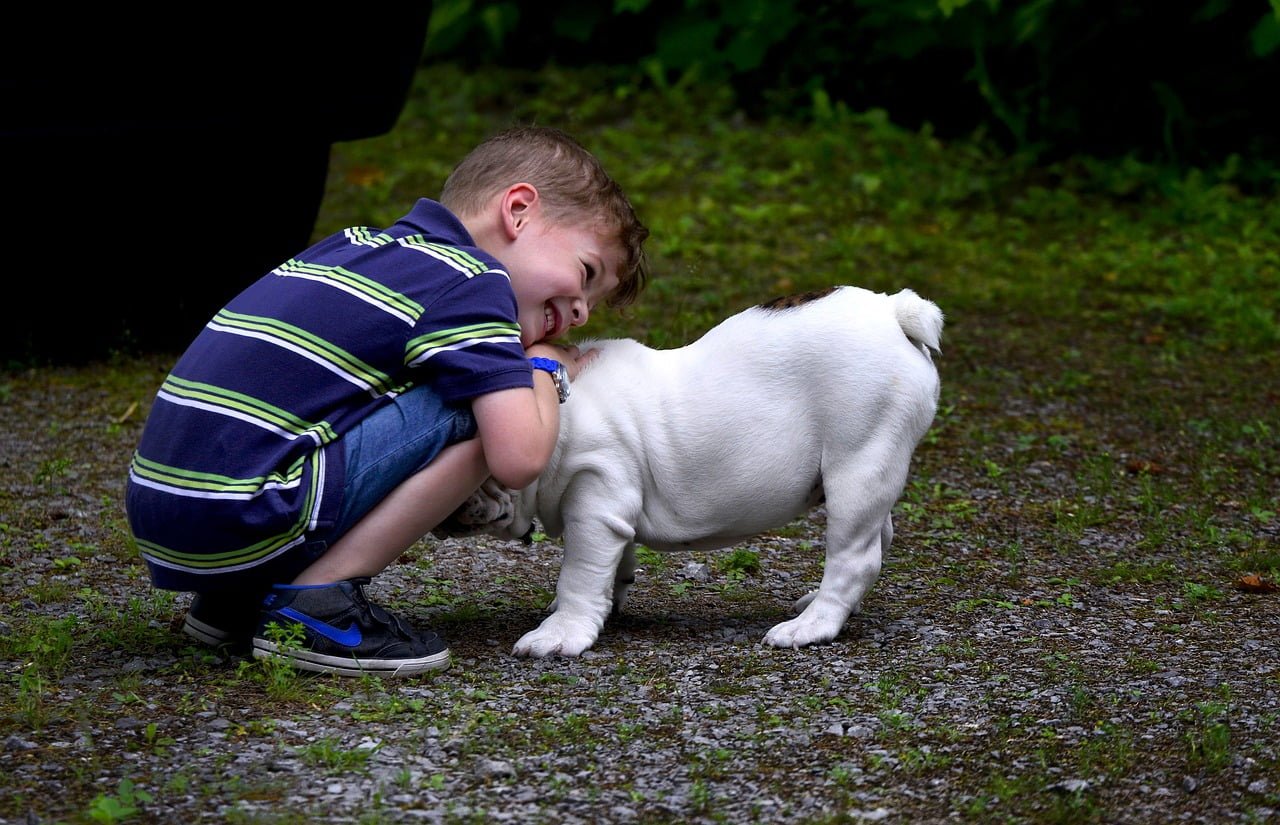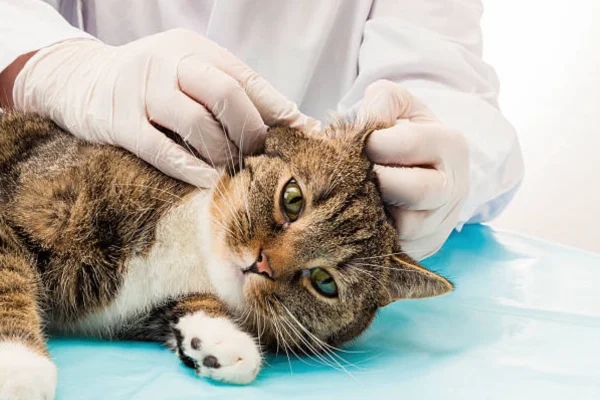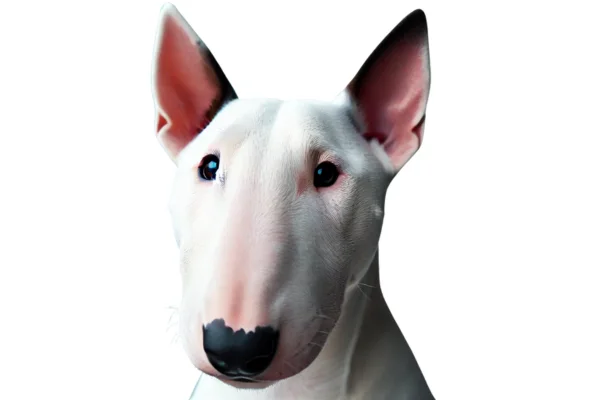Fungus in Dogs: Symptoms and Treatments
Fungi are microorganisms that can affect the health of our furry friends in a variety of ways. When we talk about fungal infections in dogs, we're referring to a range of conditions that can vary from mild to severe, depending on the type of fungus and the animal's general health. In this article, we'll explore the main symptoms, treatments and preventative measures to keep your dog healthy and fungus-free.
What are fungal infections?
Fungal infections are caused by fungi that proliferate in humid and warm environments. These microorganisms can affect dogs' skin, nails, ears and even internal organs. The most common fungal infections in dogs include dermatophytosis (known as "ringworm"), malassezia and aspergillosis.
Main symptoms of fungal infections
Symptoms vary depending on the type of fungus and the area affected, but some common signs include:
Contents
- Itching and skin irritationRed, scaly areas and intense itching are common indications of skin infections.
- Hair lossAlopecia patches (hair loss) can appear, especially in dermatophyte infections.
- Skin lesionsSores, scabs and even ulcers can appear in more severe cases.
- Secretions in the earsFungal infections in the ears, such as malassezia, can cause yellow or brown discharge and a strong odor.
- Nail changes: Fragile, brittle or deformed nails can indicate the presence of fungus.
- Systemic symptomsIn more serious infections, such as aspergillosis, the dog may have a fever, lethargy and loss of appetite.
Diagnosis
The diagnosis of fungal infections is usually made by a veterinarian, who can use various techniques such as microscopic examinations, fungal culture and DNA tests to identify the specific fungus. In addition, skin biopsies and blood tests may be necessary in cases of systemic infections.
Available treatments
Treatment for fungal infections in dogs varies depending on the type of fungus and the severity of the infection. Some treatment options include:
- Topical medicationsAntifungal creams, ointments, shampoos and sprays are often used to treat skin infections. These products help eliminate the fungus directly in the affected area.
- Systemic medicationsIn more serious cases, oral antifungal drugs such as itraconazole, fluconazole or terbinafine may be prescribed. These drugs act on the whole body, fighting the fungus from the inside out.
- Cleaning and hygieneKeeping the affected area clean and dry is crucial for successful treatment. This can include frequent bathing with medicinal shampoos and careful drying of damp areas.
- Diet and supplementationA balanced diet and vitamin supplements can strengthen the dog's immune system, helping it to fight infections.
- Environmental treatmentIn recurrent infections, it may also be necessary to treat the dog's living environment, eliminating fungi on beds, blankets and other objects.
Prevention
Preventing fungal infections is always the best course of action. Here are some tips to keep your dog protected:
- Regular hygieneRegular bathing and coat maintenance are essential. Make sure you dry your pet thoroughly after a bath or after it gets wet in the rain or swimming pools.
- Clean environmentKeep the area where your dog lives clean and dry. Avoid leaving toys, beds and blankets damp.
- Frequent inspectionCheck your dog's skin, ears and nails regularly. Any sign of irritation or abnormality should be assessed by a veterinarian.
- Vaccinations and general healthKeep your dog's vaccinations up to date and feed him a balanced diet to strengthen his immune system.
Specific cases of fungal infections
Dermatophytosis (ringworm)
Dermatophytosis (ringworm)Dermatophytosis is a skin infection caused by dermatophytes, a type of fungus that feeds on the keratin found in skin, hair and nails. It is highly contagious and can spread rapidly between animals and humans.
Symptoms:
- Circular lesions: Small circular lesions are a classic sign of ringworm. These areas may be reddened, with scaling and hair loss, often forming a circular or ring pattern.
- Scaly skin: The infection often leads to peeling of the skin, with the formation of scabs and scales.
- Hair loss: Ringworm can cause hair loss in the affected areas, leaving the skin exposed.
Treatment:
- Topical medications: Antifungal creams and ointments are applied directly to the affected areas. Antifungal shampoos are also effective in more widespread cases.
- Oral medication: For more serious or persistent infections, the vet may prescribe oral antifungals such as itraconazole or terbinafine.
- Environmental measures: It is important to disinfect the environment, including beds, blankets and toys, to avoid re-infection.
Malassezia
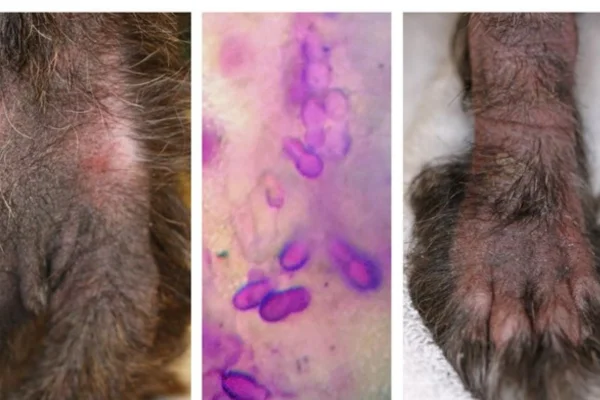
Malassezia is a yeast that normally lives on the skin of dogs without causing any problems. However, under certain conditions, it can proliferate excessively and cause infections.
Symptoms:
- Oily discharge: Malassezia infection often results in an oily, yellowish discharge, especially in the ears and skin folds.
- Strong odor: A strong, unpleasant odor is common, particularly in ear infections.
- Intense itching: Malassezia causes intense itching, leading the dog to scratch and lick the affected areas incessantly.
Treatment:
- Regular cleaning: Frequent cleaning of the ears with appropriate solutions helps to control the proliferation of yeast.
- Antifungal medication: Malassezia-specific creams, ointments and shampoos are used to treat the affected areas. In severe cases, oral antifungals may be necessary.
Aspergillosis
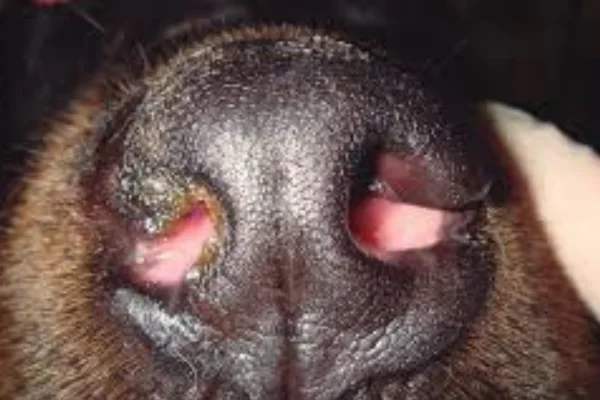
Aspergillosis is a rarer and more serious infection caused by the fungus Aspergillus, which can affect the lungs and other internal organs.
Symptoms:
- Cough: Pulmonary aspergillosis causes a persistent cough, sometimes accompanied by nasal discharge.
- Fever: High fever is common in systemic infections.
- Lethargy: The dog may show extreme tiredness and lack of appetite due to the generalized infection.
Treatment:
- Systemic antifungal medications: Medications such as itraconazole or voriconazole are used to treat internal infections. Treatment is long and can be complicated.
- Supportive care: In severe cases, intensive care and respiratory support may be necessary to help the animal recover.
Conclusion
Fungal infections in dogs can be worrying, but with the right diagnosis and treatment, most cases can be successfully treated. The key is prevention and paying attention to the first signs of trouble. If you notice any suspicious symptoms, consult a vet to ensure that your four-legged friend receives the necessary care. Maintaining good hygiene, providing a balanced diet and taking care of the environment are essential measures to protect your dog against these annoying microorganisms.
Thanks for stopping by, check out our other work too
https://vettopbr.com/cachorros/
https://vettopbr.com/tosse-em-caes/


